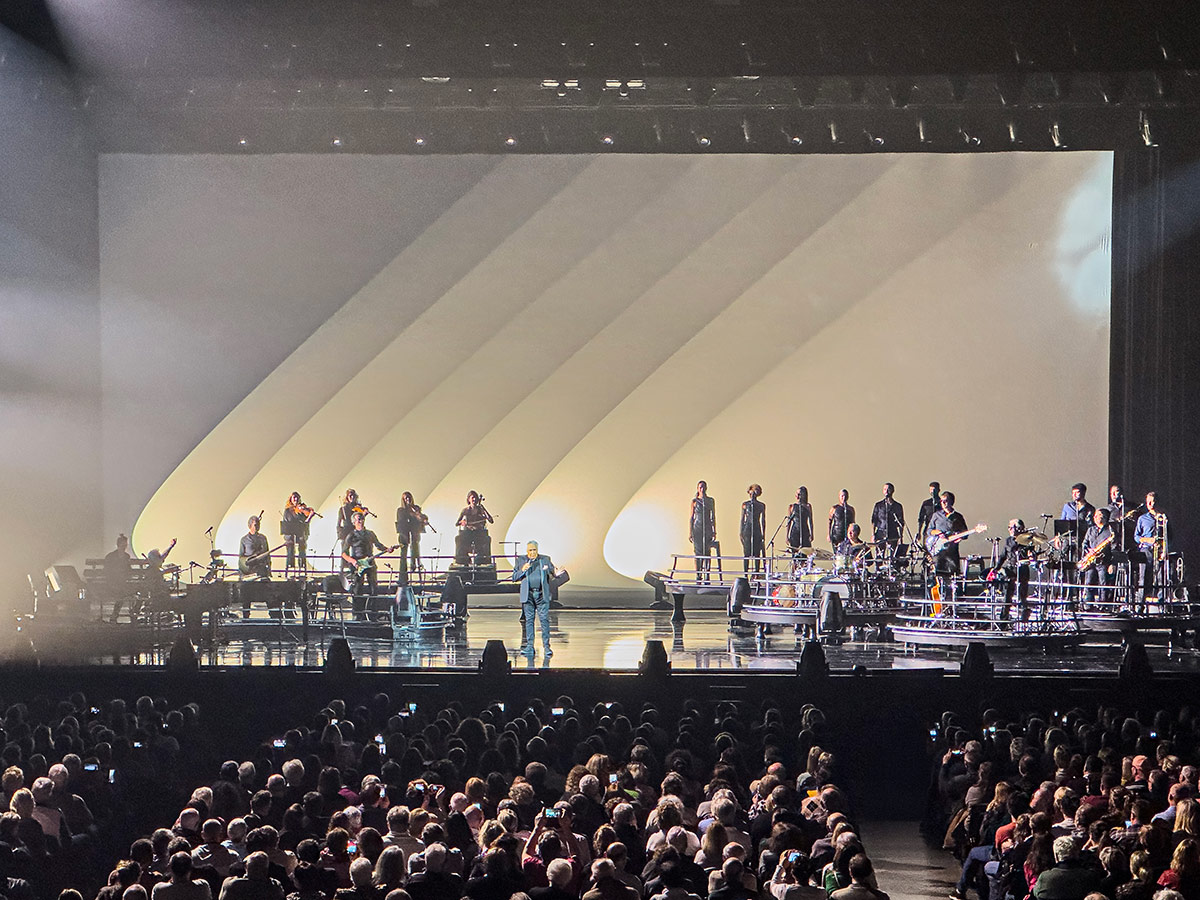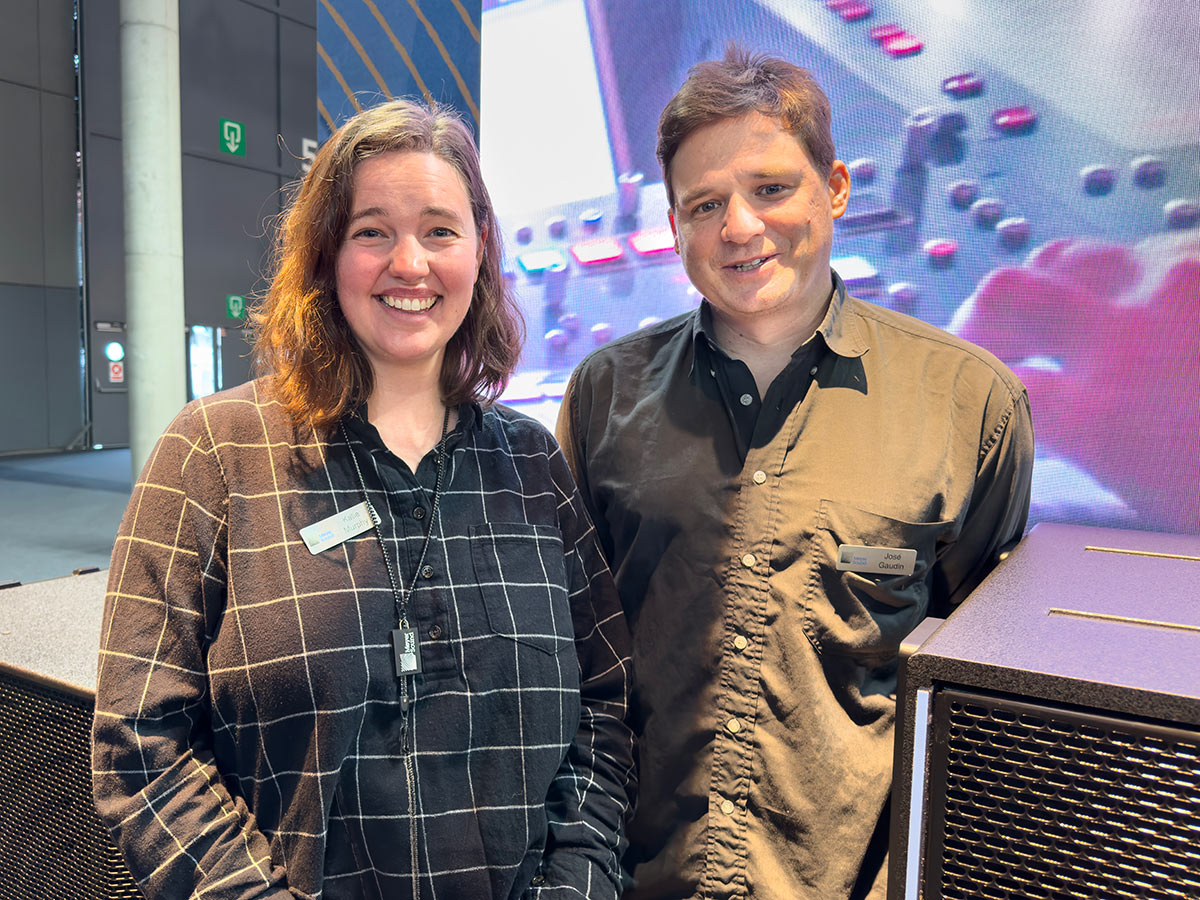
It’s been over a year since we first discovered Panther at ISE 2023 on the Meyersound stand, with a great interview with Katie Murphy and José Gaudin before we finally got to hear this first of what is likely to be a new generation of connected, lightweight and devastatingly effective products.
We headed to Bordeaux for Michel Sardou’s sold-out date at the Arkea Arena, where we had a long chat with David ‘Bart’ Omer, who is in charge of the system, and Jean-Marc Hauser, who mixes the front, before attending the sound check and the concert in a decidedly excellent venue where everything can be heard, both the good and the not-so-good. The Arena is wide open, which isn’t very often given its size.
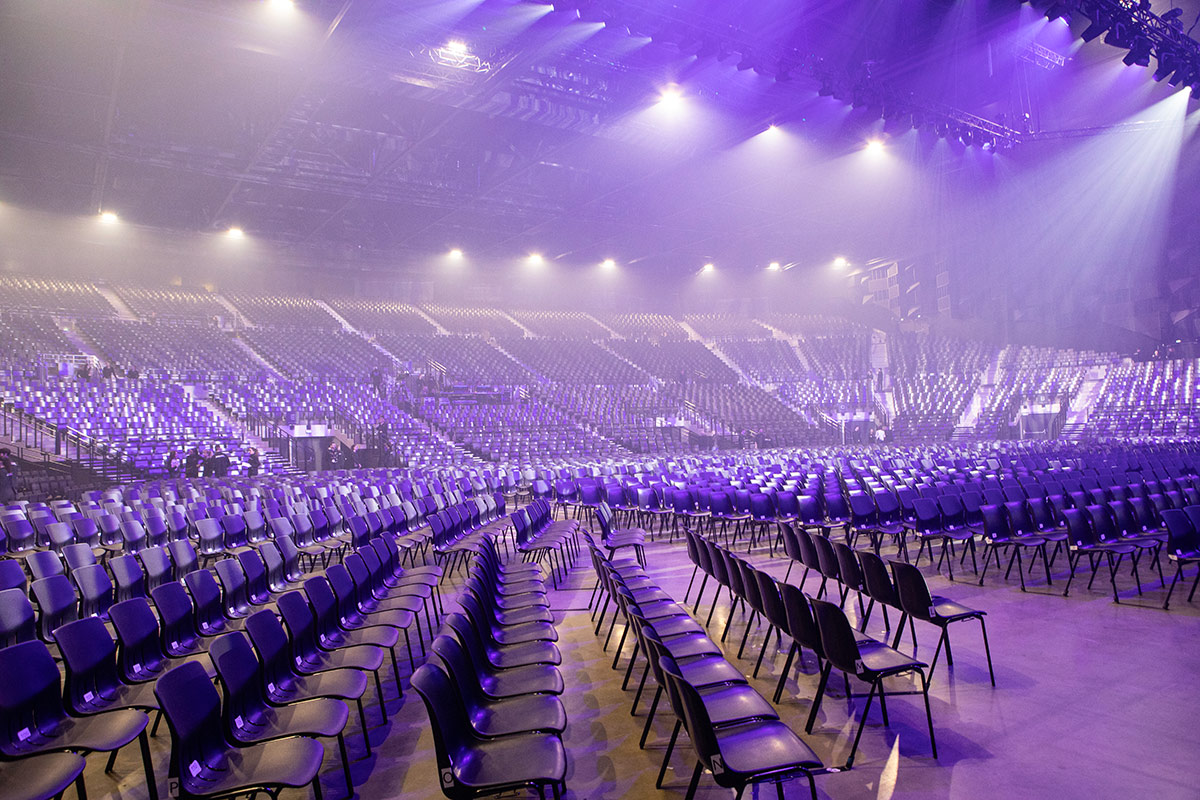
A quick look around the room reveals that the Panther is accompanied by the good old 1100-LFC. Great, we’ve got our first question for Bart and Jean-Marc who welcome us.
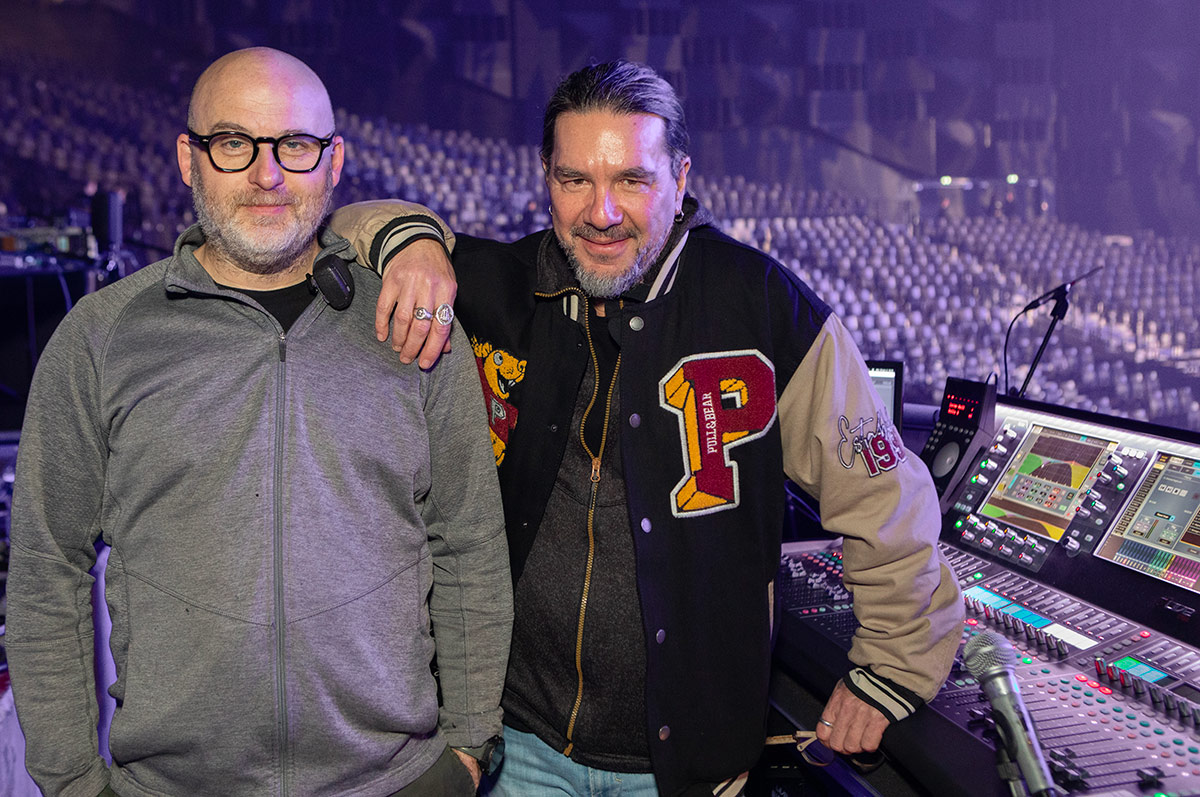
SLU : We were expecting 2100s. Did you choose to go with the 1100-LFC?
David « Bart » Omer : Yes. However, the 2100 and the 1100 don’t have much in common. The 1100 is fat with its bass reflex load, whereas the 2100 is punchier and… (Jean-Marc interrupts)
Jean-Marc Hauser : On the other hand, the subs to me…
Bart : It’s true that we use them in a special way. We cut them. In the mixer. Jean-Marc removes a lot of the infrasonic sound from his mix and I offer him a specific tonal balance to take account of this and the fairly large number of static and sensitive sensors on stage.
Without this approach, it would be difficult to mix, especially as although the 1100s play in cardioid, the Panther’s rear wave is present. The music I use as a reference is also cut at the bottom to prevent me from proposing a balance with a contour that has too much energy in the infra. The low cuts are also quite high because on stage they play jazz and breathe differently than pure pop.
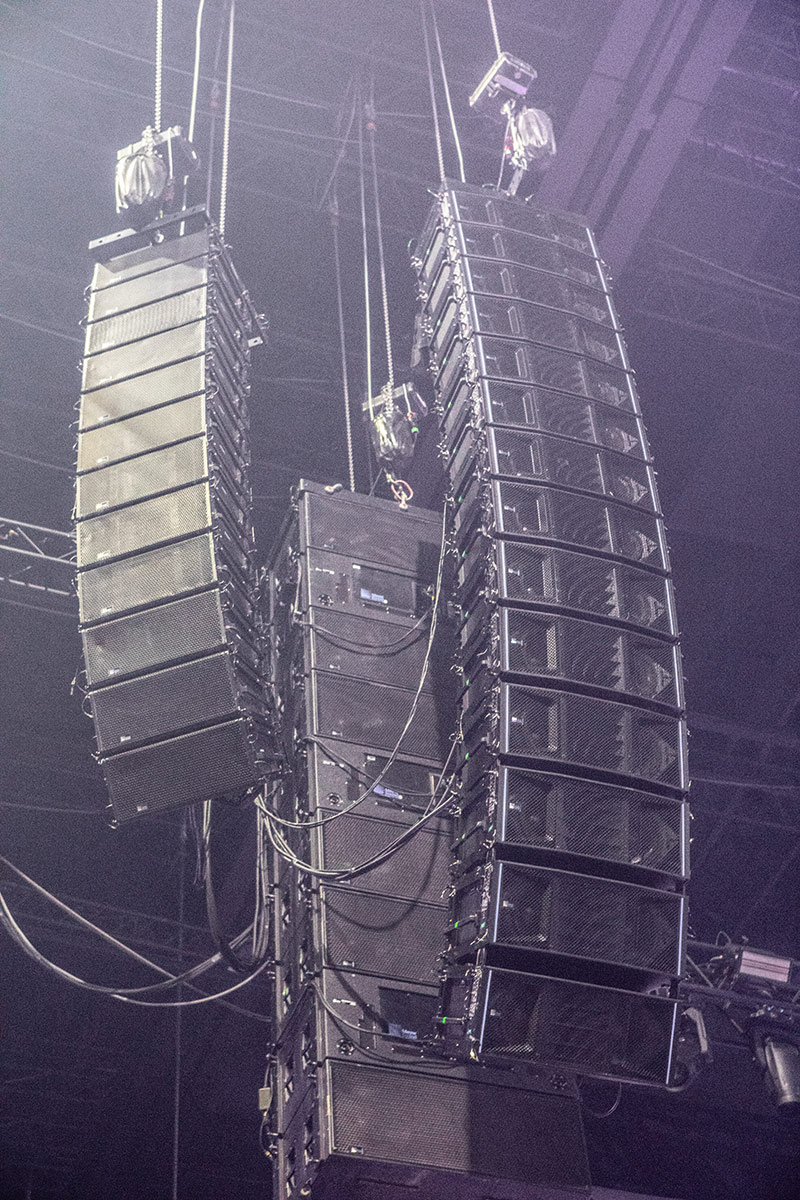
SLU : So what do you use your subs for?
Bart : To bring contour in the last octave but without excess and differently from what I would deliver for a festival. We’ve got nine 1100s per side in a cardioid arrangement, which is good enough for a venue like the Arkea Arena where six would be more than enough for me, but it’s useful for controlling directivity.
SLU : But wouldn’t you have liked to mix 2100 and 1100s?
Jean-Marc Hauser : We didn’t have the time. I wanted to do it but I should have tried first…
Bart : Especially as it would have been necessary to see how to manage the phase relationship between two products of a different generation and with a load that, in my opinion, is not the same. The 2100 is more than a simple bass reflex and deserves time to understand the product both acoustically and electrically. For the moment Meyersound is not communicating on what they have made. Marco would have cut it in half (laughs).
They’ve never been willing to comment and yet I’ve been pestering everyone! I was able to try out the 2100s a while on the Jain project, but I don’t have enough hindsight to make a judgement, plus we were in beta with frequent updates… JiBé (Jean-Baptiste Boitel), who used them at the Enfoirés (a big charity concert) with Panther, talks about “a continuous loudspeaker that goes down a little further but lacks a bit of infra”.
SLU : But you’re happy with your 1100 too
Bart : Of course, I know them by heart and I’ve got 18 on each side of the Paléo festival. In 10 years of working at this festival, apart from maybe Justice and Muse if I remember rightly, I’ve never seen the red light up on the RMS… In terms of comparison with the 2100, even the amp is different, but the 1100, which went through Legacy on Meyer’s site, is indestructible.
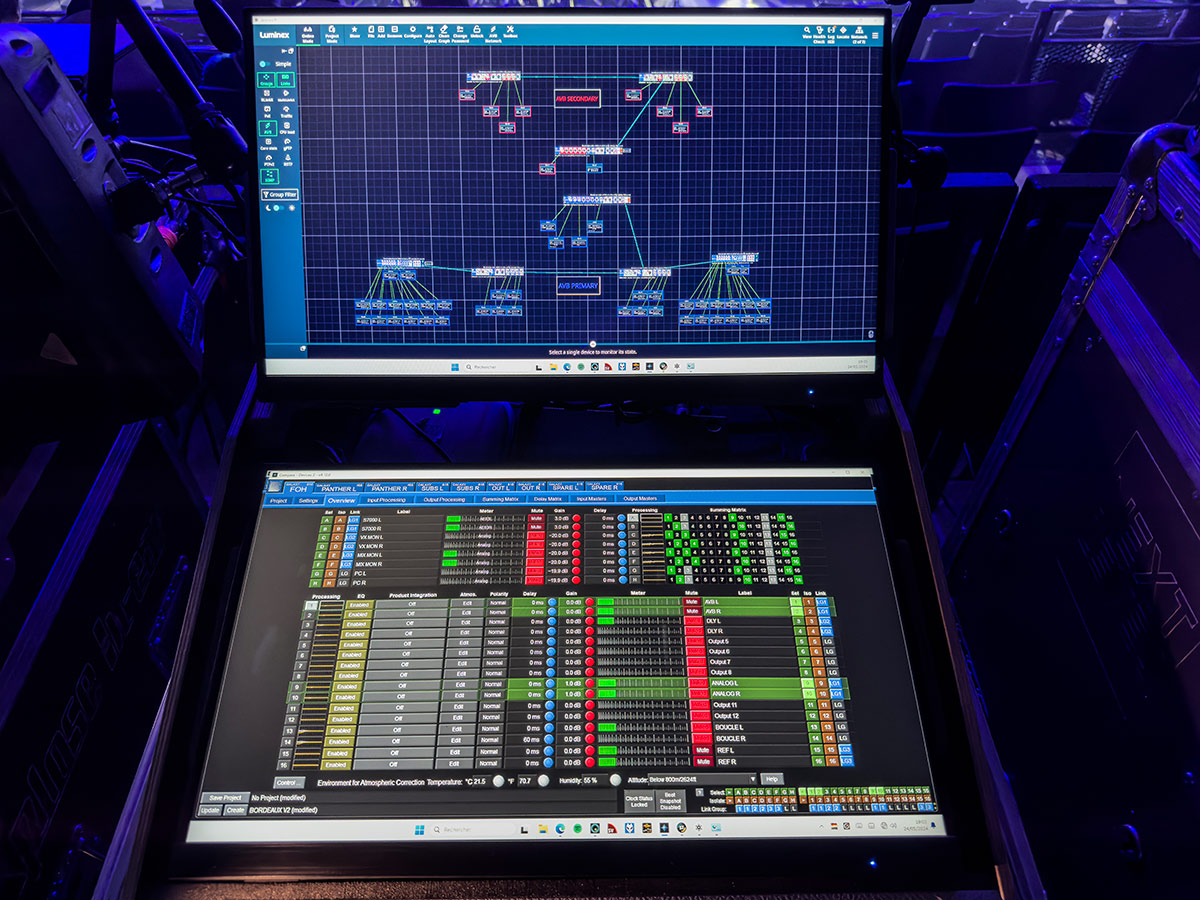
SLU : So now the audio network doesn’t stop at the Galaxy…
Bart : That’s right. First of all we have a separate primary and secondary network with a GigaCore 14R for each placed here at FOH and they go towards the stage in the direction of the GicaCore 10.
SLU : What’s with the 4 Galaxy per side you see on Nebra…
Bart : Processing! There’s still nothing in the boxes, it’s all done in the Galaxy, but now it’s in and out of the AVB. We’ve got three of them plus a spare on each side. Of course, AVB, analogue and mains are used to connect the boxes. Distribution is done by a GigaCore 30i placed in the air behind the Panthers. The analogue feed comes from FOH and we switch to analogue whenever we want.
SLU : That redundancy…
Bart : It’s my choice, I wanted it that way and Wilfried (Mautret), who manages the audio systems at Dushow, agrees with it because it allows you to overcome the possibility of a Galaxy, fibre, AVB or switch crashing… Both the AVB and analogue sources are always active on Panther, there’s no foldback in the box, so you have to create your strategy beforehand. If you lose the switch hanged up in the air for any reason whatsoever, by the time you’ve understood and solved the problem, I don’t have a system on one side at all.
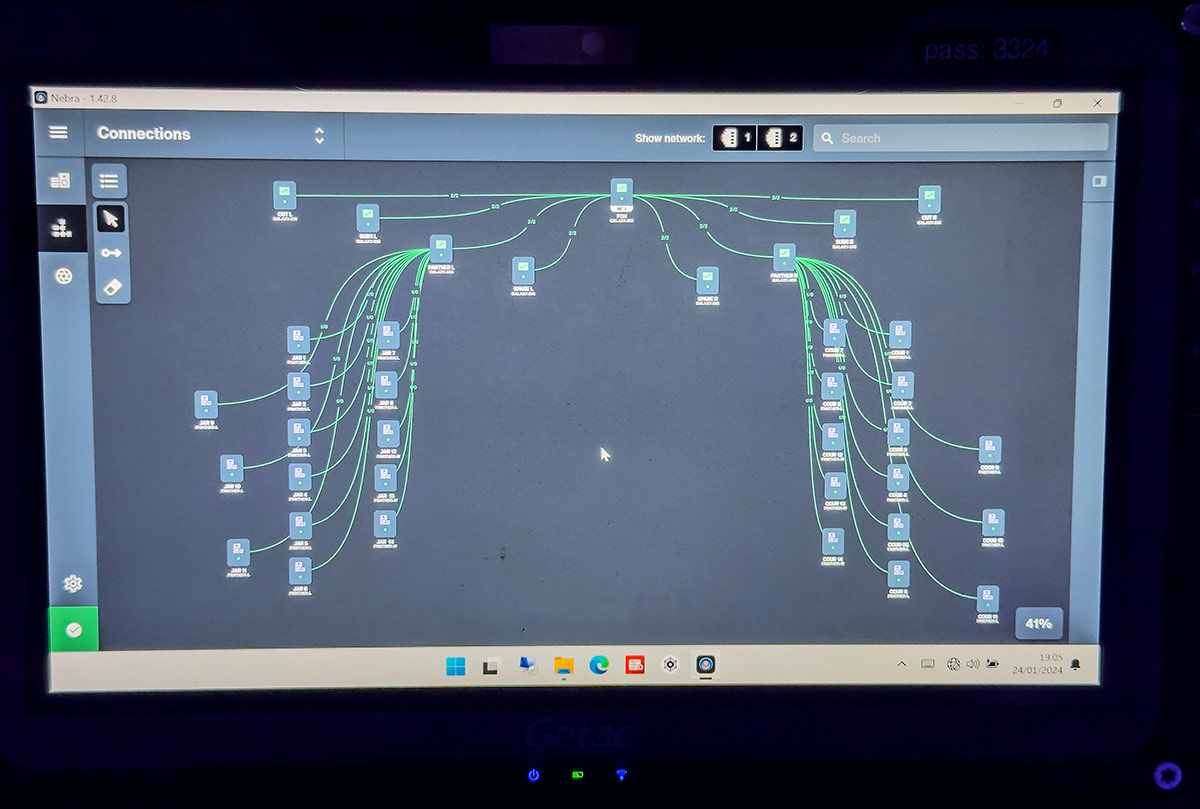
SLU : Is Meyer working hard to make things easier for you?
Bart : Yes, they’re working on it. They’re looking for the best solution between box and Galaxy and between no signal and no clock.
SLU : At the same time, you also have the speakers that come in analogue
Bart : There are plenty of them. We’ve got the 9 subs per side, the twice 12 Leopards in the outfill, the twice 6 Leopards at the height of the mantle in front of the frieze and finally we’ve got eight X20s as lip fills. The stage is wide, so we need at least this many.
SLU : The Milan AVB is a winner from a sound perspective ?
Bart : Less analogue, less conversions… it changes the sound. I left the DLive in AES, switched to AVB in the first Galaxy at FOH and from then on, we never left the digital domain until the Panthers. For the others speakers, the Galaxy that powers them switches back to analogue. Yes, we did make a small offset to align the digital boxes with the analogue ones, but it was nothing.
And this sound then !
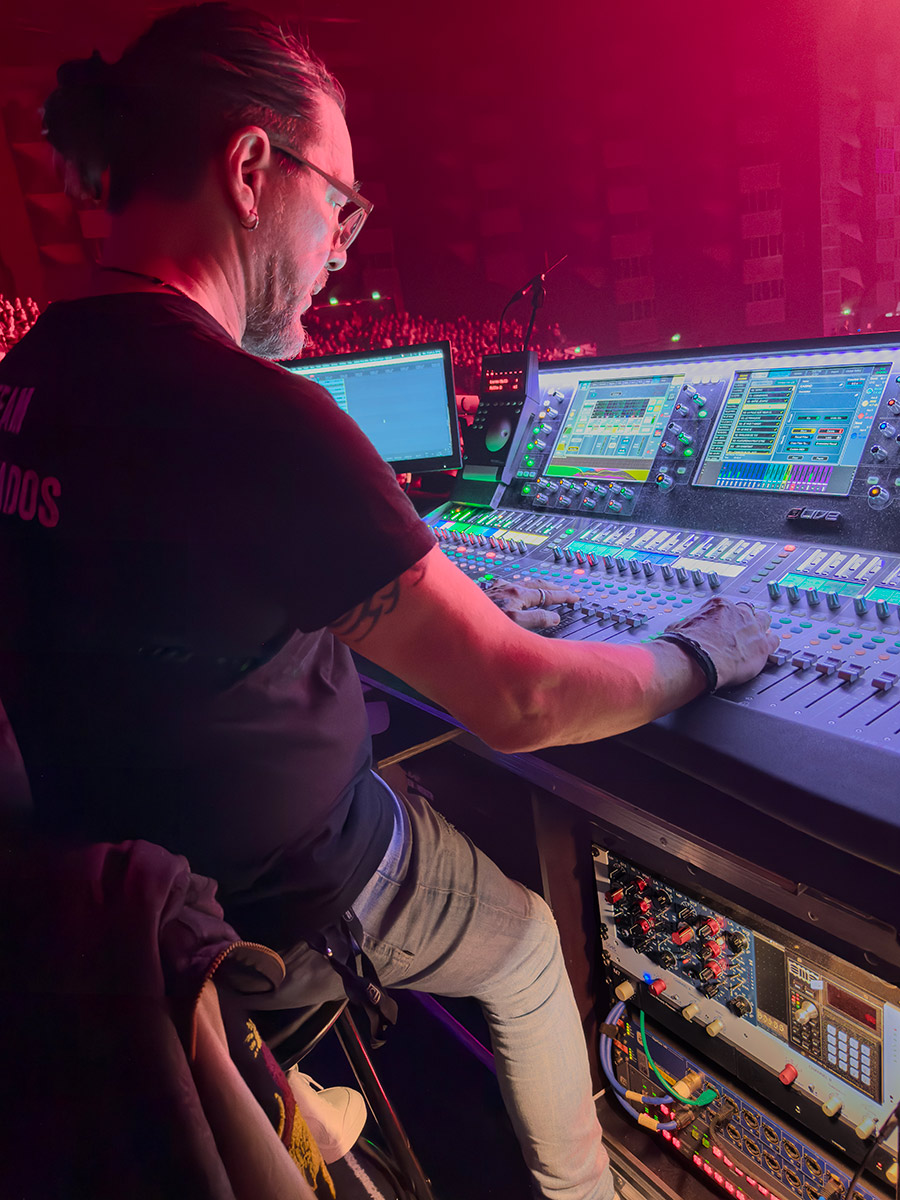
SLU : Were you the one who asked for a brand new Meyer system?
Jean-Marc Hauser : I like new tools and not having the same things all the time! I’ve changed console and system! Your ear changes, what’s happening on stage changes, but if you keep the same set-up, sitting at your desk, what’s the point?
SLU : So you ditched the Leo’s twice 15” and two 4” drivers for the Panther’s twice 12” and two 3” drivers…
Jean-Marc Hauser : I have more precision, I have less low-mid to cut, especially as the Meyersound low-mid is good compared to other systems. So I work differently.
SLU : When you first fired up the new system
Jean-Marc Hauser : I didn’t understand anything (smiles). I had to get back into something I didn’t know…
SLU : And yet it’s still a Meyer speaker, two ways with a whole lot of work for the drivers…
Bart : Yes, but it’s different. It’s not the same colour. It’s the same philosophy but in two different enclosures. There’s still the desire to have something quite massive to work with, but it doesn’t behave in the same way. The dynamics are greater, the sound is denser and more nervous and the top end of the drivers really kicks.
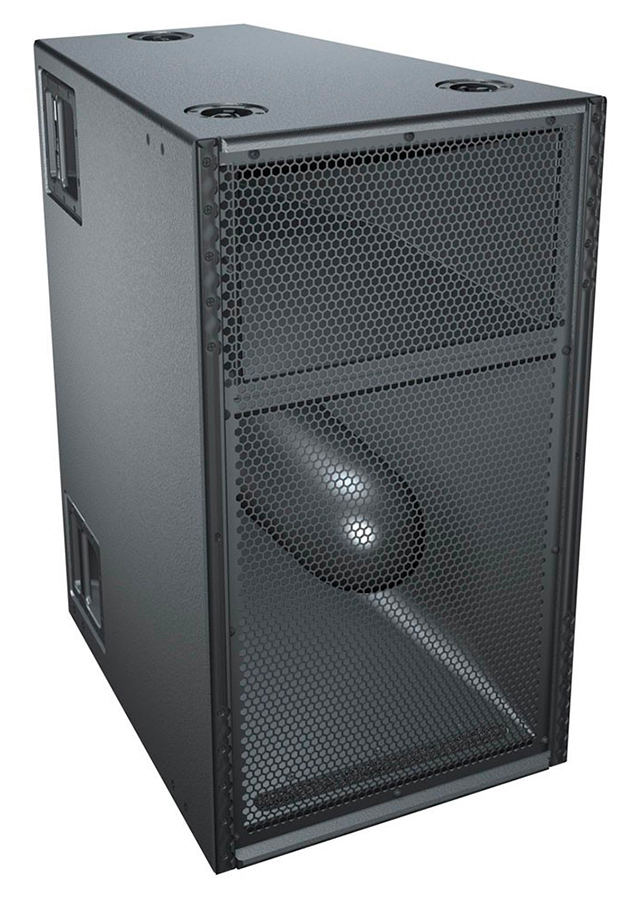
Jean-Marc Hauser : It’s pretty rock’n’roll and you have to hold your horses a bit, but it’s a blast. We’ve used a bit of everything at Meyer Sound and we really liked Leo. You know, we also liked the MSL4, it smelt of wood and sometimes beer too (laughs). After that we moved on to Milo, the M3D and when Leo showed up, we got a real kick out of it!
Bart : I did a rather difficult project at La Défense Arena for the video game world. It’s very noisy because spectators react a lot to what they see and there are hosts in the room who talk over the top of that.
We had Leo and Panther in 360° with a lot of height because of the screens. When we went through the Panther at 60 metres, we had an incredible projection of the treble. We didn’t have that in the Leo, so we went looking for it. We don’t know if it’s due to the Class D or the transducers, but you can definitely hear it.
SLU : But the two-way concept has always appealed to you
Bart : It’s not the easiest box to make. You have to think it through, choose the right components and build a real loudspeaker without thinking that everything else will be compensated for by the processing, and that’s where Meyer are very good.
Jean-Marc Hauser : They weren’t the quickest to catch up with other brands, but they caught up well. Of course, amplified loudspeakers are not very well known in France. In some ways, people don’t like them, even though there are many advantages.
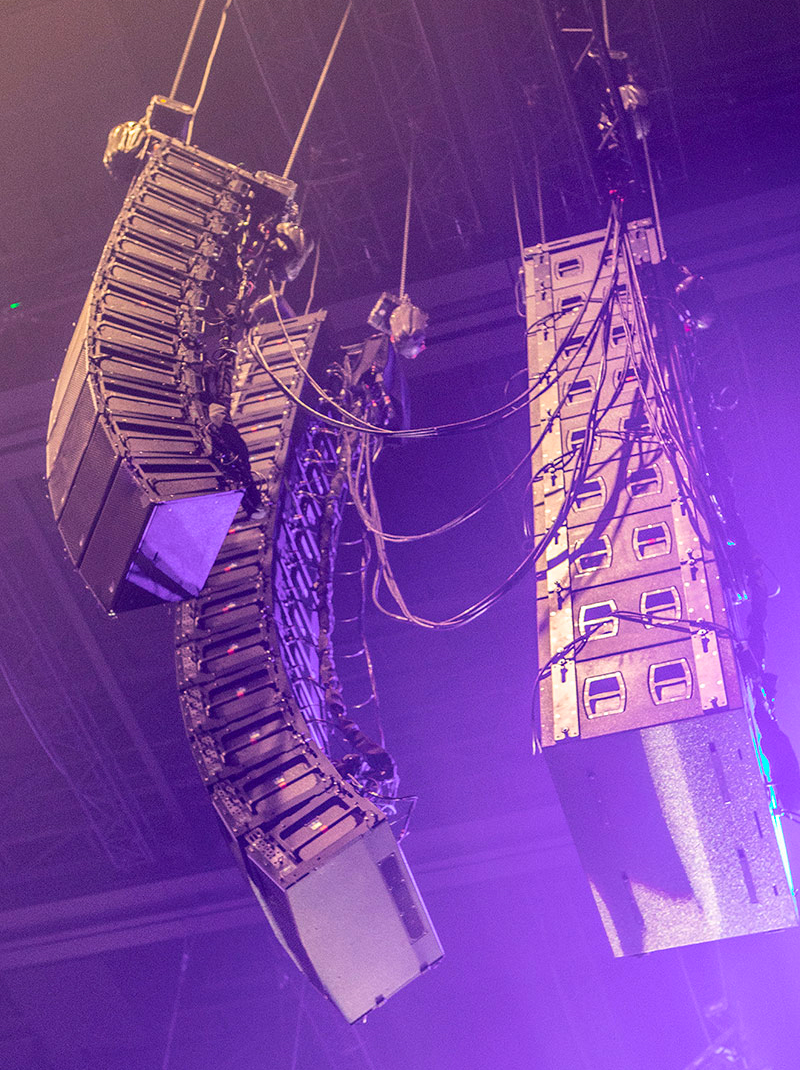
Bart : On the other hand, it’s true that in terms of work habits, it’s not the same and you have to have a harness nearby (laughs). More seriously, working with Meyer is pleasant because they are creative and the technician who operates a system is really part of the equation, but it requires knowledge of the brand and an interest in electroacoustics.
A technician who has been rigidly taught a manufacturer’s workflow, applies a recipe and doesn’t have solid initial and theoretical training, will struggle a bit.
But if you have the skills upstream, ask yourself the right questions and understand what you’re doing and why you’re doing it, the products and software may not be the same, but everything will be fine because the concepts are identical. It’s sad to be a mono-brand, because I like to travel. It allows me to explore. It takes time, but it opens up my mind a little.
SLU : Speaking of software, is RMS actively preparing for retirement?
Bart : Not yet because Nebra can only handle AVB boxes at the moment. More specifically, it can import RMS but it has to be able to handle both networks at the same time. At the moment we’ve got a compatibility issue between the Windows 11 network card, Nebra and Compass, which is causing my computer to reboot on its own, but we’re working on that, it’s a problem linked to our computers. I could run updates on the motherboard, but on tour… how can I put this (laughs)
SLU : What about weight?
Bart : It’s another world, especially as we’re often faced with load problems. On Michel’s last tour we had 12 Leos and 3 Lyons, now we have 14 Panthers. We gain 700 kilos per side. We lift with two one-tonne engines, whereas with Leo it was two tonnes.
SLU : Is the sound trailer empty tonight?
Bart : Yes, everything came off and it’s up and running. It all fits in a trailer without you having to work like crazy. We took the road with one amplifier back for each range of boxes.
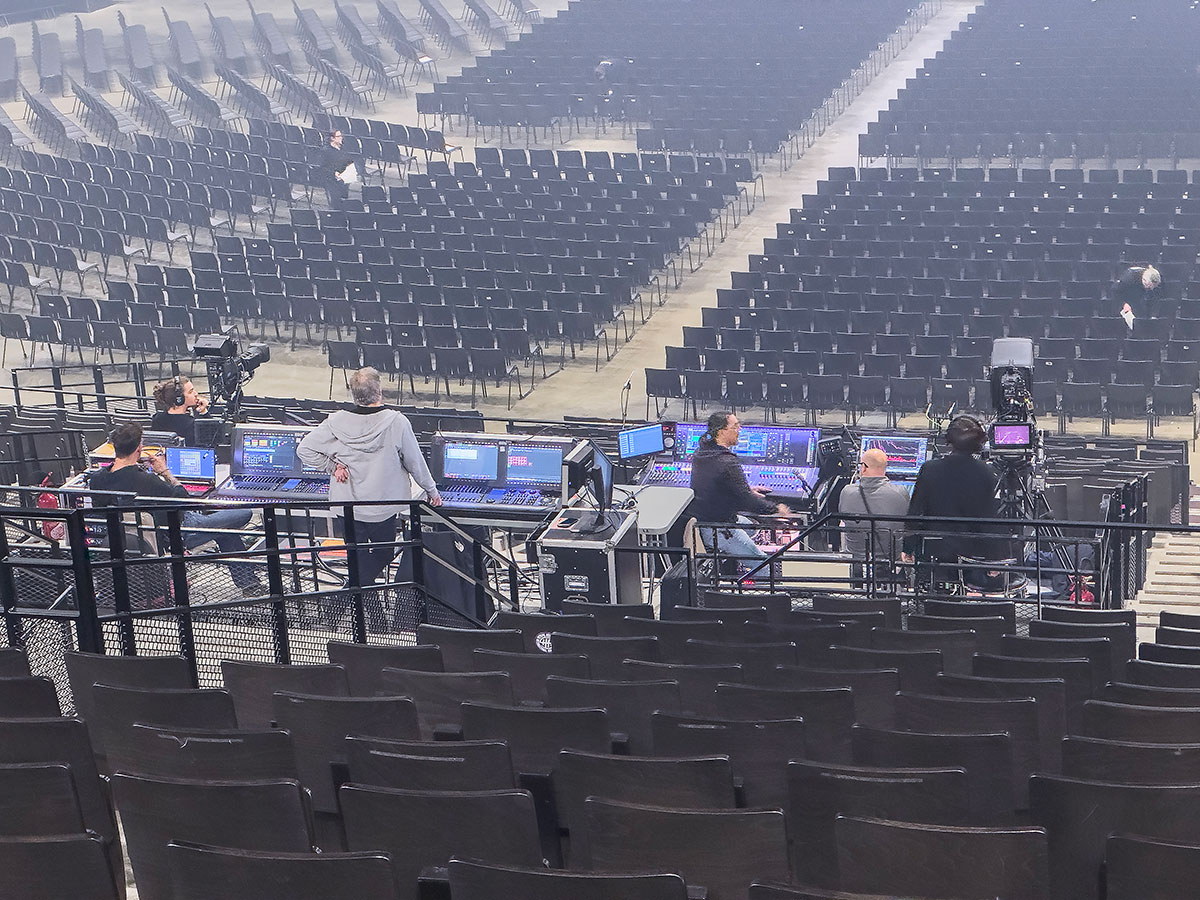
SLU : The Bordeaux venue has superb acoustics
Bart : The little echo you get is the cyclo at the back of the stage and the two small screens stage left and right. I was thinking to myself this morning as I was setting up the room, the noise of the ‘construction site’ like the slings; even when the rig goes up, it’s much quieter and the big noises don’t resonate. That changes everything.
SLU : You’ve been accompanying Michel for a while now. Anything new?
Jean-Marc Hauser : 20 years, after all… Nothing special in terms of pick-up for the boss, we have Sennheiser Digital 6000 transmitters with KK 204 Neumann heads. I have a Bricasti M7M with its remote control as the main reverb.
For violins I have a Neve 5045 which allows me to gain a bit of level before feedback. It works like an expander, a sort of Dolby on the ambient noise, and because of its action, it also removes the usual ‘squeak’ with the cells. I prefer anyway the DPA 4099s.
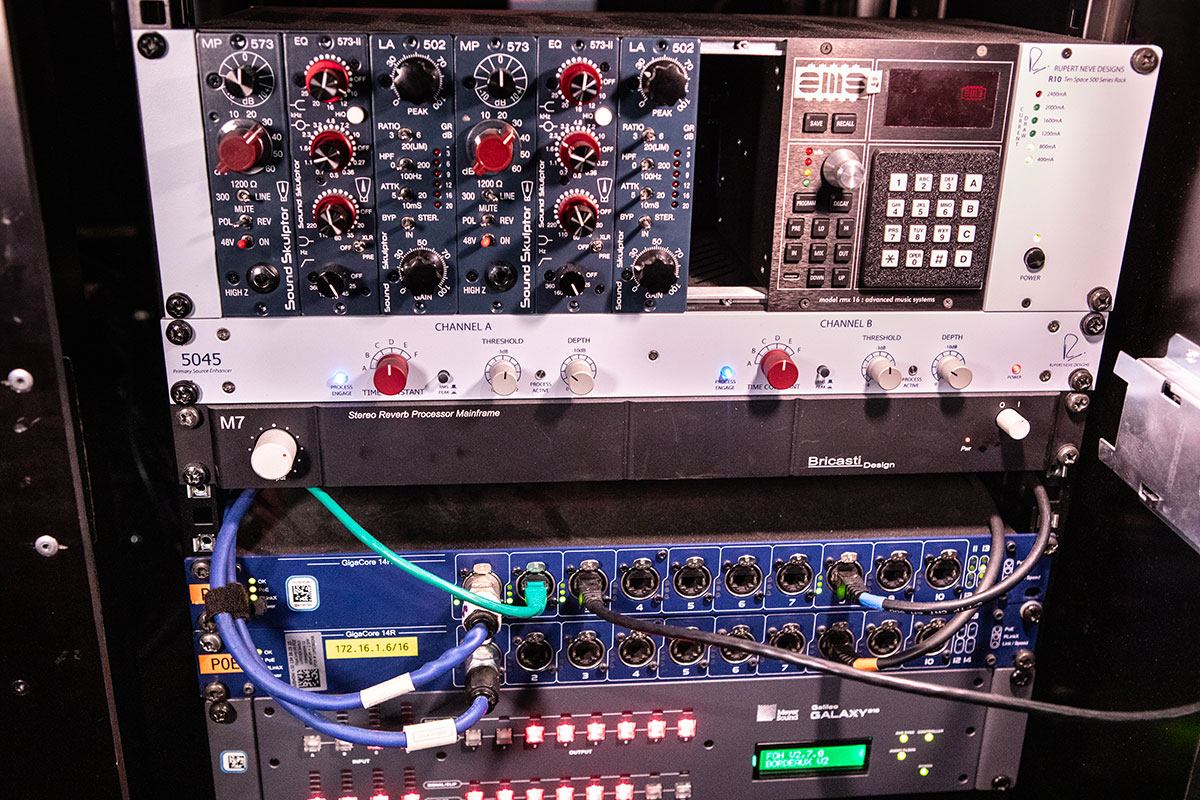
SLU : Above the Bricasti, in a luxury rack for 500 modules from Neve, you can see a baby RMX 16 from AMS…
Jean-Marc Hauser : I use it for the long reverbs on Michel’s voice and the Bricasti for the short ones.
It’s Neve who makes it smaller. It’s not exactly the original 19” 2U rack version but it looks very similar and it’s not bad at all.
I’m still listening to the venues and I’m not pushing the consumption of reverb, in some rooms there’s already quite enough of it, especially on busy, fast tracks.
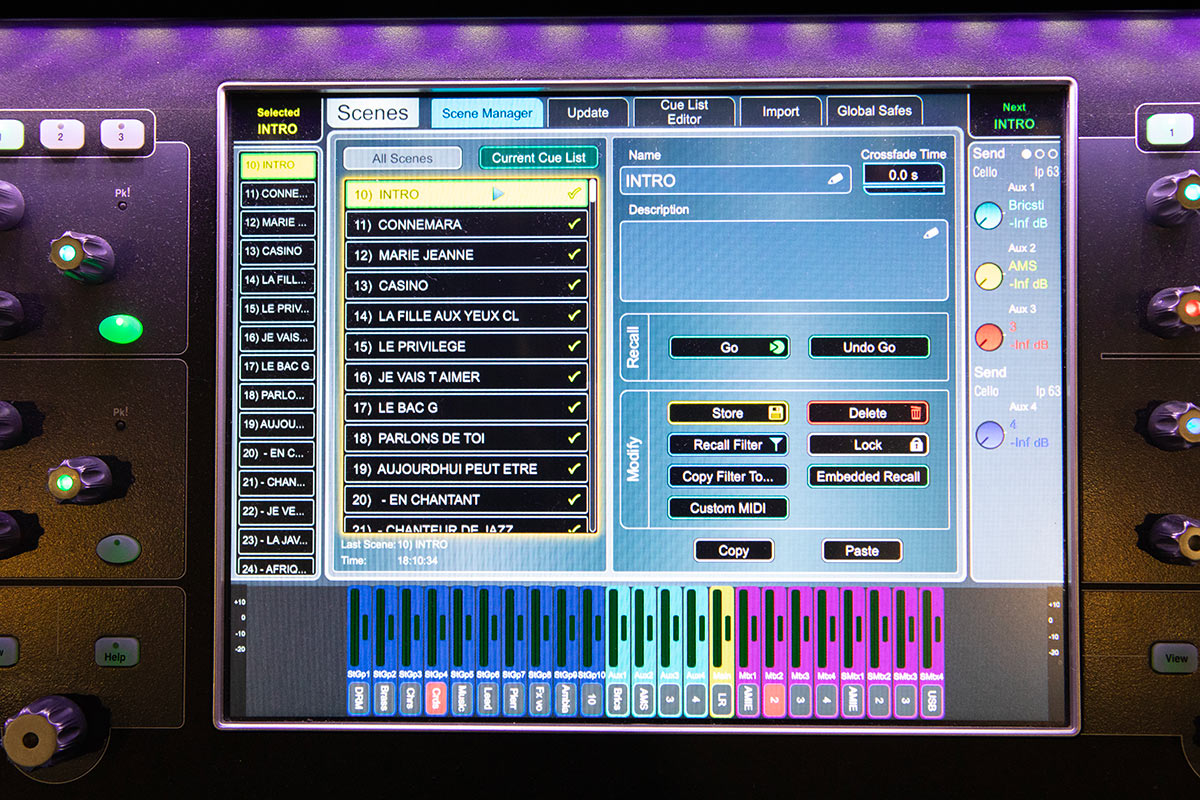
SLU : But in a healthy, “short” venue like the Arkea and with a system that’s more analytical and active at the top end of the spectrum, it’s tempting, isn’t it?
Jean-Marc Hauser : I use reverb, but it stays within the mix. The other modules are Michel’s vocal chain, main and spare. They are Sound Skulptor.
I’ve got two Class A preamps and 573 passive EQs, copies of 1073 Neve console slices and two 502 optical compressors that emulate the LA-2A.
I took them because they’re super handy if I need to lighten the voice a bit above 10 kHz and as low-pass filter. I’m already cutting in the console but I find it ‘fat’, so I’m saving myself this external possibility. I’ve got a local stage rack to interface all this.
SLU : You’re not using anything else on this tour? No plug-in servers?
Jean-Marc Hauser : I don’t need it and, above all, I don’t want it. I prefer to work the old-fashioned way, that saves bugs (smiles). For the violins, for example, I use the console’s reverb. I even use a dozen of them and I find that of all the consoles I’ve worked with, the dLive ones work the best. There are also LA-2A emulations that I like, studio memories, interesting delays, dynamic EQs, and so on. It’s very complete and it’s quiet (it pushes its master a bit).
SLU : There’s a little thermal noise and a bit of 50 in the background, isn’t there?
Jean-Marc Hauser : Aaaahhh the analogue, it’s still alive and well and we do have a tiny 50Hz but we love it, it reminds us of the good old days. All we need now are the MSL4s!
SLU : So happy with dLive
Jean-Marc Hauser : Of course. I’ve been mixing FOH and monitors with this console and there’s an interesting Recall Safe system. It’s super simple to set up and you can really work properly. Laurent Midas has a good number of them and he’s delighted, as is François Brély, and in terms of value for money, there’s nothing better on the market.
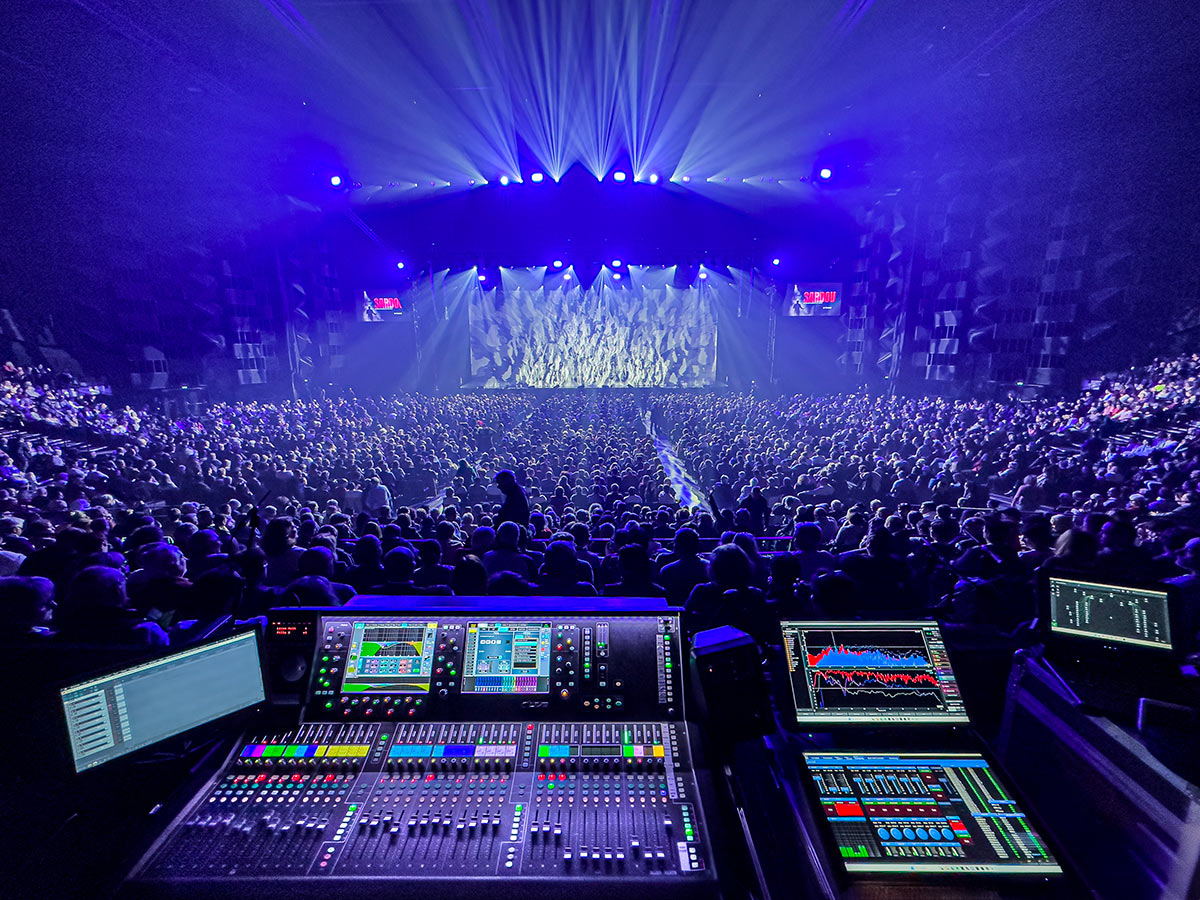
Curious as ever, we took advantage of the fairly long sound check in Bordeaux to wander between the floor and the huge tier of the Arkea Arena and our first observation was that the little Leopard from the outfills held up fairly well. The contour is virtually identical and the transition from Panther to Leopard is well balanced in terms of phase and tonal balance.
When, after a few minutes, you go the other way, you have to admit that the clarity, finesse and dynamics of the Panther’s treble are superior, even if, in SPL terms, you can’t be far off. Michel’s voice comes out very well on both, but with more spunk, crispness and precision on the face.
It’s like Eugène Delacroix’s painting “La liberté guidant le peuple”. We loved it before it was cleaned up and rejuvenated, we adore it now. Whether it’s the 100% digital link at last, the class D, the new transducers, the work on the waveguide or a combination of all these reasons, the fact is that you almost have to hold on to the Panther’s treble, something quite unprecedented at Meyer Sound.
We climbed all the way to the top to reach the furthest point of the lines arrays, this evening 72 metres, and despite a small cap overhanging the last 4/5 rows of seats and a more unfavourable direct field/reverberation ratio, the top of the spectrum arrived without a problem, even a little better than the lows. If you move down a few rows and get out of the cap, you’ll find excellent, highly defined sound.
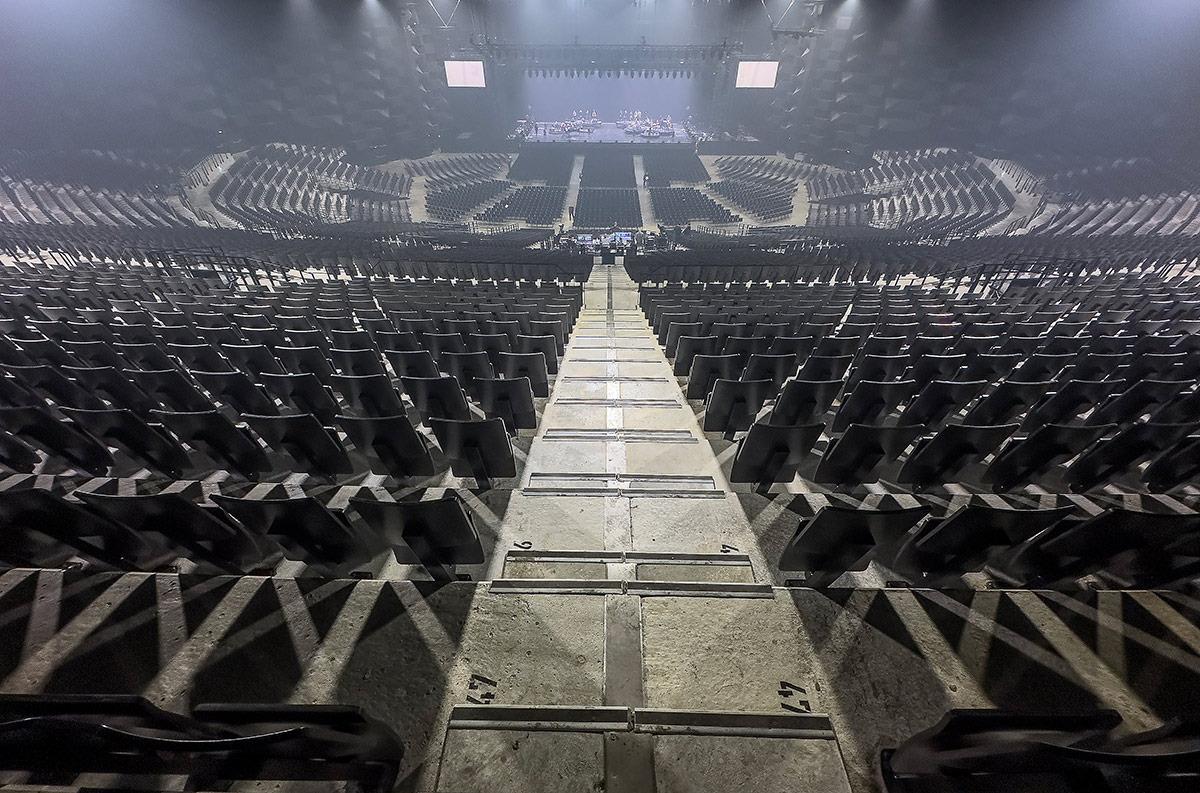
All that’s left is the usual compromise of the parterre near the nose of the stage where the Leopard showers drench, the X20 front fills blow a little and the main system starts to chirp. There’s impact and sound, but it comes from many sources and you can hear it.
The sound with a capital S returns as soon as we get into Panther’s mouth, and then it’s a completely different story. Even more so than with the crossing into the side stands, you can feel an unprecedented power and density, a real, real big sound that Jean-Marc’s mix, as accurate and rock solid as ever, really brings out.
Three hats off to you in conclusion.
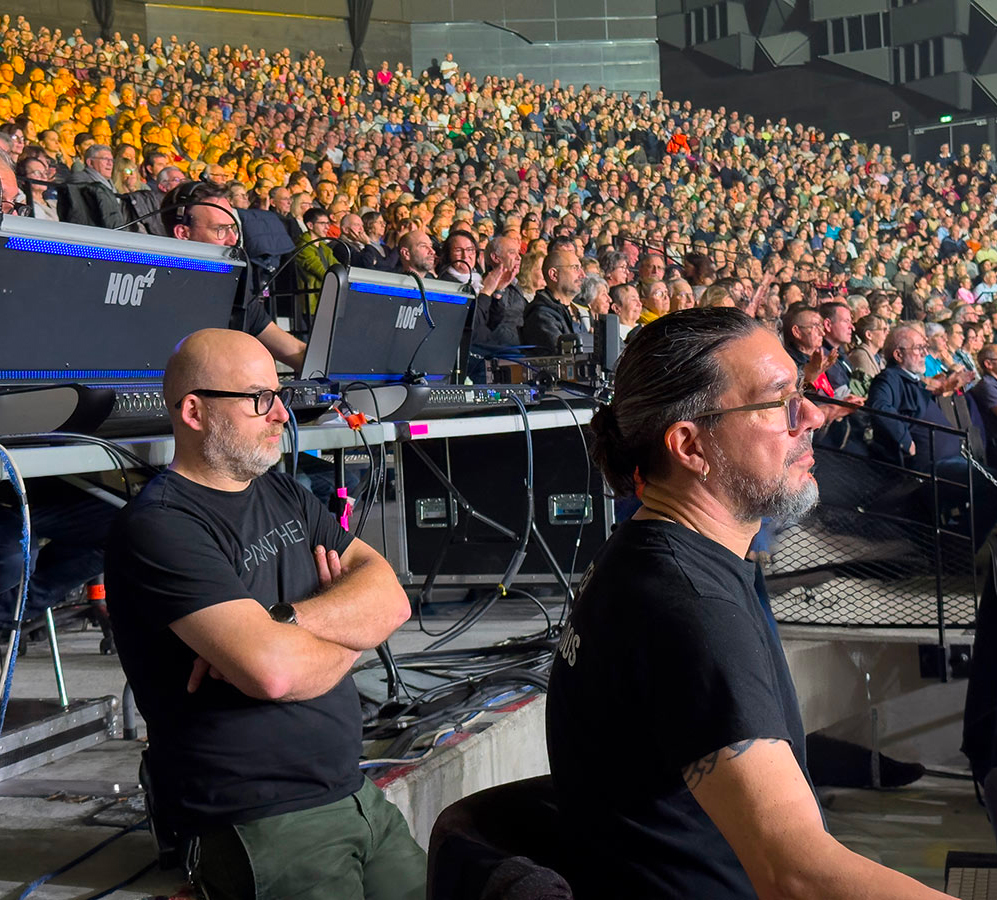
One to the Hauser Omer couple. Experience runs through their veins, they love and know how to make good sound and they complement each other like a pin in a lock. I’d go on tour with them as serene as Michel always was, without forgetting that Stage left les GéGé, Génix & Gares are watching over the monitors.
Second to Meyer, who can now more than ever be called Meyer Sound. Meyer Good Sound indeed. Gone are the days of being overweight, traditional and having to carve out a chunk of lows to unmask the highs. From now on, and without having sold their souls to the devil, the sound pushes hard, clear and resutely modern. It was about time.
And thirdly, Michel Sardou. You either like him or you don’t, but we respect the artist who has made millions of people sing and thousands of technicians crumble. Now it’s the turn of the youngsters, and good luck in making the same career ;0)
